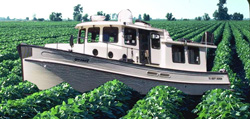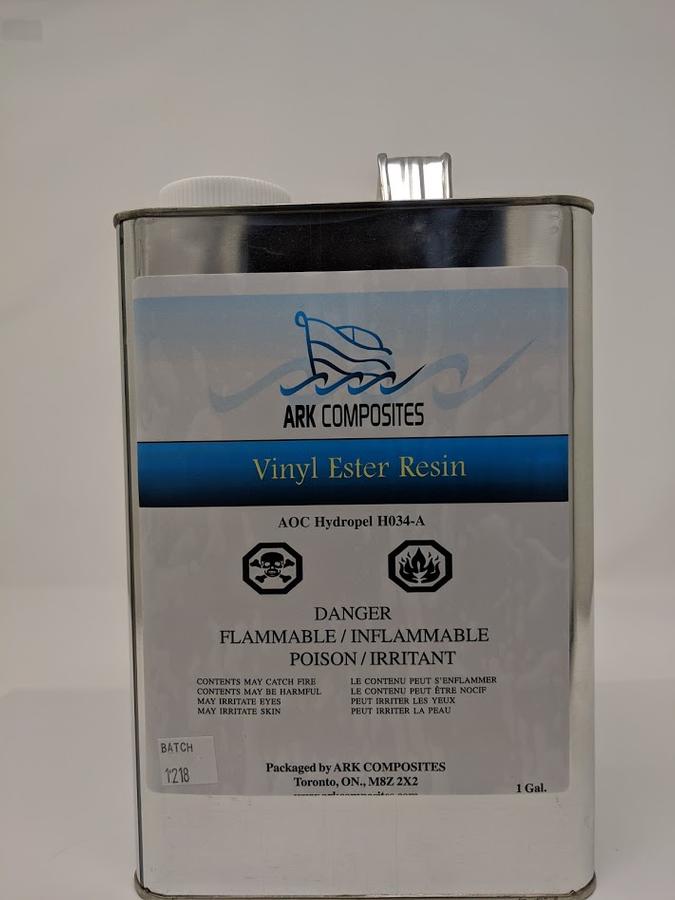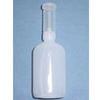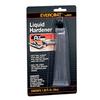Waxed or unwaxed?
When purchasing polyester resin, why do the labels specify "waxed" or "unwaxed"? What's the difference?
Most polyester-based fiberglassing resins will not cure when exposed to air, they need a barrier to separate the resin from the air. In unwaxed resins, the top layers of the resin itself acts as that layer, allowing the resin under it to cure, while this top layer stays tacky (uncured). This surface tack makes unwaxed resin ideal for larger, multi-layer projects, as the bond between layers is excellent. It is also the resin used against a mold surface, as waxed resin will tend to release while curing.
Waxed resin has wax suspended in the resin. This wax forms a surface film when the resin is applied, separating ALL the resin from the air, allowing it ALL to cure. It is used when the resin or gelcoat is the final layer and a non-tack surface is needed. It is also the type of resin to use before finishing with paint, although the wax must be removed with a proper wax and grease remover prior to painting. The wax takes about 24 hours to set up hard, and you can add addition fiberglass lay-ups on top without any preparation within that time.
That being said, epoxy-based fiberglassing resins are stronger and less brittle. Epoxy is more expensive but tends to be a more pleasant experience - we highly recommend them! It is important to note that while epoxy can be applied on top of polyester, it is very difficult to attain proper adhesion when applying polyester on top of epoxy. In other words, do not use polyester over epoxy! If you must do it, make sure to thoroughly sand the epoxy surface and be prepared to re-do the job at some point in the future as delamination can occur.
MAKING BETTER PLASTIC BOATS
and the future of Bio-Resins
The Life Cycle of FRP (Fibre-Reinforced Plastic)
Almost all modern recreational boats are constructed from fibre-reinforced plastic, often simply called "fibreglass". FRP is exactly as it sounds; a hardened plastic resin strengthened and stiffened by reinforcing fibres (usually glass fibres, though carbon and aramid are often used in high tech applications).
Due to its plastic properties, in many ways FRP is a miracle product for consumers, and one of these miracles is its lifespan. Plastic seems to last forever! However, while the hull of a 40 year old boat might be in good shape, there aren't too many people in the market for vintage plastic boats; what happens when an FRP-based boat reaches the end of its life?
Unlike wooden or steel hulls which can be broken down or recycled, there is less certainty in the afterlife for a plastic boat. Some are simply scuttled to the bottom of the bay. Sometimes they are set ablaze. Some are crushed and sent to the landfill. However, these are not solutions; they merely pass the burden to someone else.
At Pride Marine, we are eager to see a transformation in boat construction. We believe that in the near future, there will be three major revolutions in the life cycle of FRP:
- Boats will be made with materials that mimic traditional FRP but are made from renewable materials.
- Leading builders will design and produce LEED-certified boats
- The vast majority of FRP-based boats will be reused and/or recycled
Designing Better FRP: Bio-Derived Resins
We are not chemical engineers at Pride Marine, but to the best of our knowledge, polyester resin can be created from the mixture of:
| INGREDIENT | SOURCE | |
| maleic anhydride | (produced from butane) | |
| + | ethanol | (alcohol) |
| + | oil | (petroleum) |
| + | glycol | (ethylene) |
| + | styrene | (extract from Styrax trees) |
In theory, you could lower each of these compounds' carbon footprint in the following ways:
- Ethanol: Derive from corn or other plants rich in starches and sugars
- Oil: Derive from oil-rich plants or grasses such as soybeans, canola, hemp
- Maleic anhydride and gylcol: Possibly produce from gases similar to biogas?
- Styrene: Preservation of forests in SE Asia (for growth of Styrax trees)
Manufacturers are slowly developing ways to work renewable materials into the resins, not only to make their boats more "environmentally-friendly", but to potentially lower the cost of manufacturing in the future, due to the speculation of rising prices for petroleum-based and non-renewable products.
 Polyester resin manufacterer Ashland introduced commerically available polyester resins developed with a significant amount of renewable materials - in this case, soybeans (oil) and corn (ethanol). The product is called "Envirez" and according to Jamie Tanner of Ashland, the product quality meets (and in many cases) exceeds its petroleum counterparts. Envirez is available to boat builders, but so far none is being distributed in smaller quantities for the chandlery shelves.
Polyester resin manufacterer Ashland introduced commerically available polyester resins developed with a significant amount of renewable materials - in this case, soybeans (oil) and corn (ethanol). The product is called "Envirez" and according to Jamie Tanner of Ashland, the product quality meets (and in many cases) exceeds its petroleum counterparts. Envirez is available to boat builders, but so far none is being distributed in smaller quantities for the chandlery shelves.
In January 2010, Campion Boats (based in Kelowna, BC) introduced its first powerboat developed from Envirez resin. According to Brock Elliot of Campion, they have also produced hull and deck parts for the Martin 16 sailboat (used for disabled/adaptive sailing) and have plans for producing more boats in the future.
On the surface, the use of bio-resins immediately reduces the carbon footprint of boat manufacturing. However, the concept of bio-resins (and bio-fuel) is somewhat controversial as it can lead to increased food prices. However, bio-resins (and bio-fuels) are still in their infancy. Tests are underway using alternative products, such as varieties of grass. Could these alternative crops can be grown in areas where food is harder to grow, or during times of drought? Could they be grown alongside food crops, rather than in place of them?
Both Campion and Ashland are moving forward in this regard, eager to find alternatives to the food chain. In 2010, Campion was recognized by the Kelowna Chamber of Commerce for their "Green Practices" and also we were the only boat company in the world recognized at Ft. Lauderdale Boat Show when BOATING Magazine gave out for the first time ever 10 Eco Awards. Is this a sign of things to come?
LEED-Certified Boats
LEED (Leader in Energy and Environmental Design) is becoming a revolution in architecture and building design. New office and residential projects are now commonly being awarded with various levels of LEED certification, indicating significant efficiencies and green initiatives in the construction and use of these spaces. Some of the criteria include:
- Energy savings
- Water-use efficiency
- CO2 emissions reduction
- Improved indoor environmental quality
- Stewardship of resources and sensitivity to their impacts
So why not build LEED-certified boats? Currently, LEED specifications for maritime vessels do not exist, but it is only a question of time; we believe the certifications will soon be established, and the first generation of LEED boats will be headed to market in the near future. While boats are already far more effective in using resources compared to our homes and offices, there is plenty of room to grow because our impact is directly absorbed by the environment. Features on LEED-certified boats will most likely include LED lighting, solar/wind electricity generation, fuel-cells or bio-diesel engines, greywater recycling, and the use of recycled materials, sustainably harvested wood products, hardware built by manufacturers with high environmental standards, and perhaps most significantly, a thorough recycling program to deal with the boat when its life is effectively over.
The End of the Road: Reusing/Recycling of FRP
Unfortunately, our industry has given very little attention to the question, "what happens when the product has been used up?" When a petroleum-based (or bio-resin) boat reaches the end of its life, can it be recovered and recycled? Very few boaters are aware of the options available, and simply leaving the boat where it lies is often what happens.
However, there are three viable ways in which an FRP boat can find new life.
- Intense grinding into powder, for use in future FRP materials
- Pyrolysis, the thermal degradation of polymers into base materials
- Rebuilding/Re-outfitting/Reuse
Grinding: Using promising technologies such as Seawolf's (www.seawolfindustries.com) grinder and macerator can turn FRP materials into a useful powder, which when mixed with virgin materials, can be used in several products. When mixed with new resin, the powder can be transformed into an extremely strong, lightweight substrate that can be used in place of wood or concrete - such as rot-proof fencing, curbs, decking. As well, this FRP powder can be sprayed, allowing users to build molds and casts or apply unbelievably strong reinforcement material in seconds.
Pyrolysis: This process is similar to incineration but occurs in the absence of oxygen and at about 500 degrees Celcius. Pyrolysis breaks polyester FRP into three distinct forms; gas (8.5% by weight), oil/wax (45.7% by weight) and solid residue (45.8%).
The gas is primarily carbon dioxide and carbon monoxide, which obviously isn't very useful. The oil/wax left behind could have uses as either fuel or a chemical source - but so far there don't appear to be many takers. The solid residue, mainly glass fibres, however, could be quite useful. The strength of these fibres is compromised at 800 degrees or above, so this relatively low temperature process leaves behind fibres which could certainly be used in future FRP projects.
Reuse: From a product life aspect, FRP has a lifespan of over 50 years, so hopefully most "vintage" boats can be reinforced, rebuilt and outfitted with new equipment and be enjoyed by a new owner. This is unlikely for many boats, but in many regions, such as the Great Lakes, the market for used boats is quite healthy.


















